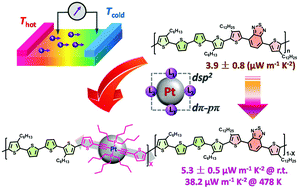Optimizing the thermoelectric performances of conjugated polymer backbones via incorporating tailored platinum(ii) acetylides†
Abstract
Efforts to improve the electrical conductivity (σ) levels of organic semiconductors constitute a critical challenge for achieving high-performance organic thermoelectric (TE) devices. Herein, five new conjugated polymers incorporated with different relative amounts of platinum acetylides, and denoted as P0, P1, P5, P10 and P100, were synthesized, and all of them demonstrated good solubility in commonly used solvents. UV-Vis-NIR absorption and X-ray photoelectron spectroscopy measurements showed that the doping behaviors of these polymer backbones can be manipulated by tailoring their contents of platinum acetylides. Notably, the introduction of heavy-metal complexes was shown to offer an effective strategy to realize both high Seebeck coefficient (S) and σ values for the polymers, attributed to the enhanced through-bond coupling between the metal d-orbitals and the neighboring π-orbitals. Therefore, P1 at ambient conditions showed a significantly improved power factor (PF) of 5.3 ± 0.5 μW m−1 K−2, a 35% enhancement relative to the 3.9 ± 0.8 μW m−1 K−2 value for the primary P0 without platinum. Moreover, after further optimization, P1 at 478 K yielded a PF approaching 40 μW m−1 K−2.



 Please wait while we load your content...
Please wait while we load your content...